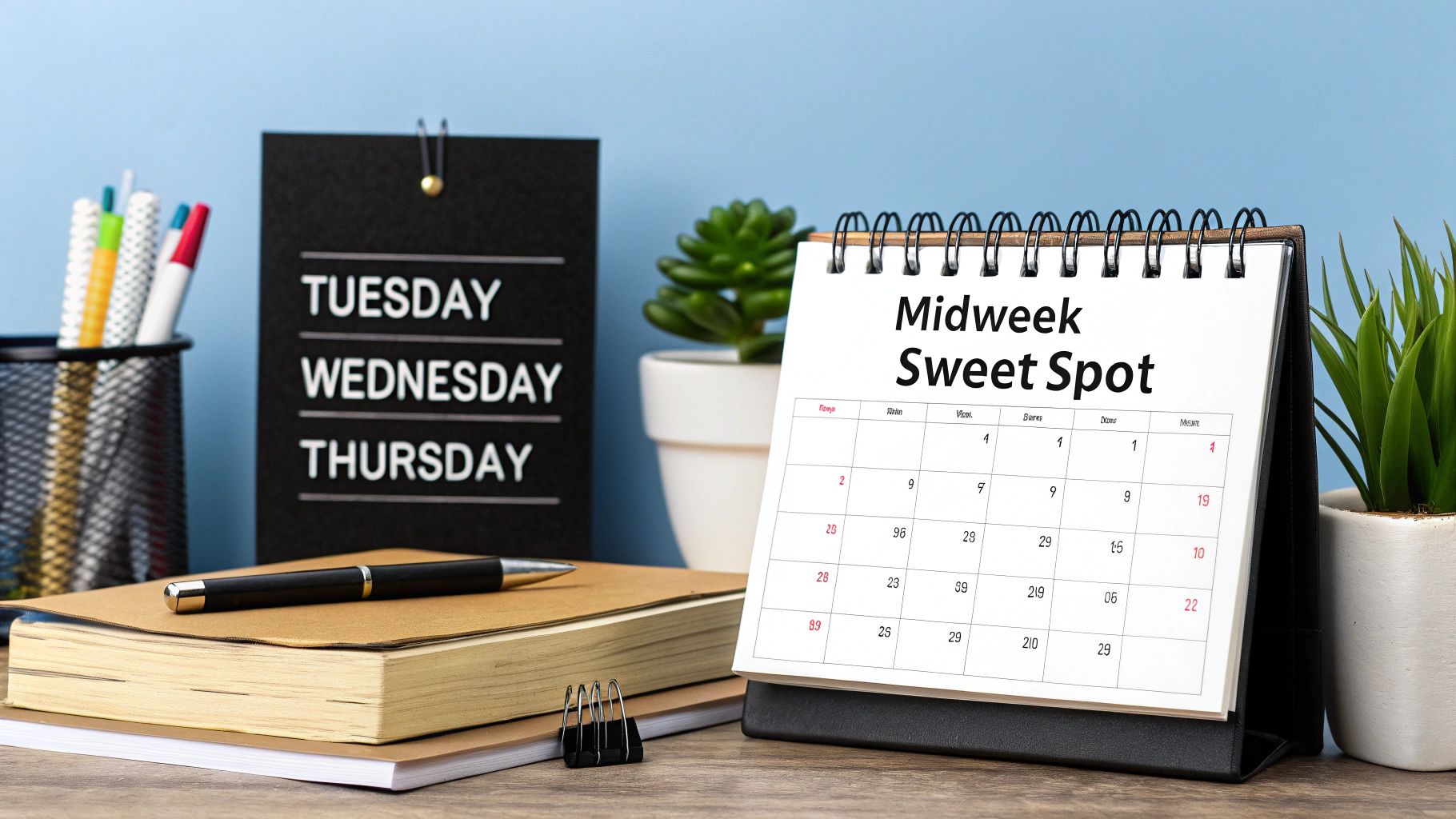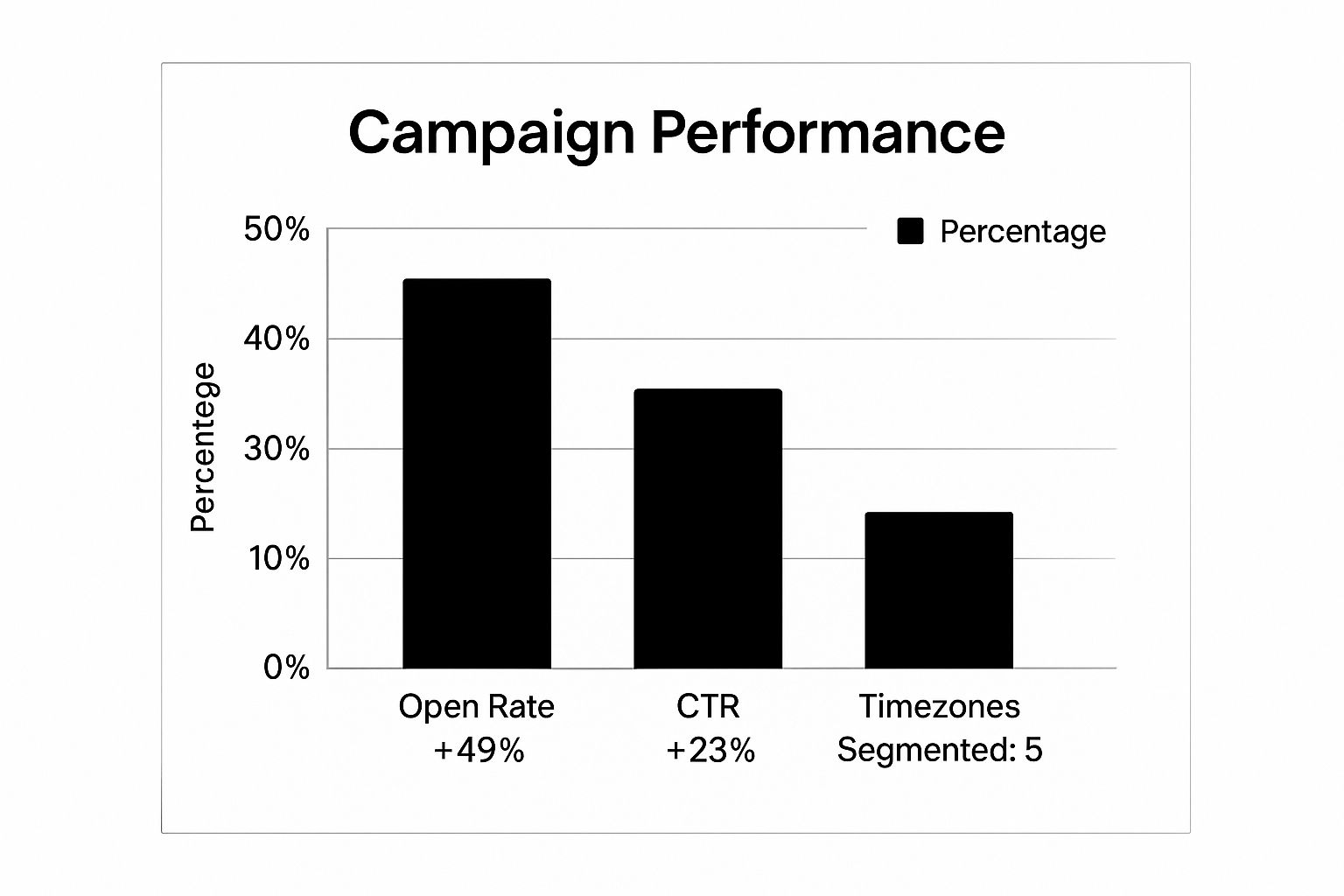Best Time to Send Cold Emails in 2025: Top 6 Tips
- Prince Yadav
- Jun 10
- 13 min read
Unlocking the Secrets of Cold Email Timing
Timing is critical for cold email success. A perfectly crafted message sent at the wrong time can easily get lost in the inbox. This detailed guide reveals six data-driven strategies to pinpoint the best time to send cold emails, boosting your open, click-through, and response rates. Knowing the best time to send cold emails can dramatically impact your campaign's success. This article will explore why timing matters and how to avoid common pitfalls.
This listicle will cover six key strategies for optimizing your cold email timing:
Tuesday to Thursday Mid-Week Sweet Spot
Early Morning Professional Hours (8-10 AM)
Late Afternoon Decision Window (4-6 PM)
Avoid Monday Mornings and Friday Afternoons
Timezone Personalization Strategy
Industry-Specific Timing Optimization
By implementing these strategies, you can significantly improve your cold email performance. We'll dive deep into each of these points, offering actionable advice and real-world examples. Let's maximize your cold email success by hitting "send" at precisely the right moment.
1. Tuesday to Thursday Mid-Week Sweet Spot
Capitalizing on the mid-week workflow is a cornerstone of effective cold emailing. Sending your campaigns on Tuesday, Wednesday, or Thursday consistently yields higher open and response rates compared to other days of the week. This strategy leverages peak productivity periods while sidestepping the pitfalls of Monday's inbox overload and Friday's pre-weekend distractions. Targeting this sweet spot allows your message to land when recipients are most engaged and receptive.

This mid-week approach acknowledges the natural ebb and flow of office life. Mondays are often consumed with catching up on backlogged tasks and internal meetings after the weekend. Conversely, Fridays find many professionals mentally checked out, anticipating the weekend break. By focusing on Tuesday, Wednesday, and Thursday, you position your email for maximum visibility during peak work engagement.
Why the Mid-Week Works
The effectiveness of this strategy is supported by data from industry leaders. HubSpot's analysis of 20 million emails revealed a 17.3% open rate on Tuesdays, compared to 14.7% on Mondays. Mailchimp data consistently highlights Wednesday as a top performer across various industries. Furthermore, SalesLoft's research indicates that Thursdays generate 23% more replies than Fridays.
Actionable Tips for Mid-Week Success
Test and Refine: Don't rely solely on general statistics. Track your own audience's engagement over a 4-6 week period to pinpoint their peak responsiveness within the Tuesday to Thursday timeframe. This personalized approach allows you to fine-tune your sending schedule for optimal results.
Industry Insights: Consider the unique rhythms of your target industry. Certain sectors may experience higher engagement on specific days within the mid-week window. Researching these nuances can give you a competitive edge.
Timezone Targeting: Always schedule your campaigns based on the recipient's local timezone. This ensures your email arrives at the optimal time for their workday, maximizing the chance of it being seen and acted upon.
Holiday Awareness: Avoid sending emails on days immediately preceding or following holidays. These periods often see reduced engagement as people are focused on time off, leading to lower open and response rates.
Optimizing Your Mid-Week Strategy for the Best Time to Send Cold Emails
Implementing this mid-week strategy requires a thoughtful and tailored approach. Simply sending emails on Tuesday, Wednesday, or Thursday is not enough. By understanding your audience, respecting their time, and adapting to their specific rhythms, you can significantly enhance the effectiveness of your cold email campaigns and achieve higher conversion rates. Learn more about using cold emails effectively. Remember, the "best time to send cold emails" is ultimately determined by the unique characteristics of your target audience. Continuously analyze your data and adjust your strategy accordingly.
2. Early Morning Professional Hours (8-10 AM)
The early morning window between 8-10 AM represents prime email real estate. Professionals are more likely to check and respond to emails during this time. This timing catches recipients during their morning routine when they're prioritizing their inbox. They also have the mental energy for new communications.

This approach capitalizes on the fresh perspective people bring to their workday. Before the demands of meetings and tasks take over, many professionals dedicate their first hours to reviewing emails and planning their day. By landing in their inbox early, your message has a higher chance of capturing their attention and prompting a response before other priorities emerge. This is particularly relevant when determining the best time to send cold emails.
Why the Early Morning Works
Data consistently supports the effectiveness of early morning email delivery. Boomerang's analysis revealed that emails sent at 8 AM had a 45% reply rate compared to 23% at 1 PM. Campaign Monitor's research found that sending emails at 6 AM in the recipient's timezone increased open rates by 31%. Yesware's data shows that 9 AM generates the highest response rates for sales emails, further solidifying the power of this early bird approach.
Actionable Tips for Early Morning Success
Timezone Targeting: Send your emails at 8 AM in the recipient's local timezone. This crucial step ensures your message arrives when they are most likely to be actively engaging with their inbox.
Compelling Subject Lines: Craft clear, benefit-focused subject lines that immediately grab the recipient's attention and convey the value of your message.
Immediate Value: Ensure your email provides value from the first sentence. Get straight to the point and highlight the benefits you offer.
Test and Refine: Experiment with sending times between 6 AM, 8 AM, and 10 AM to identify the optimal window for your specific audience. Don't just assume 8 AM is universally ideal.
Optimizing Your Early Morning Strategy for the Best Time to Send Cold Emails
While the 8-10 AM window offers a strong starting point, maximizing its potential requires a strategic approach. Understanding your target audience and tailoring your message to their specific needs are essential. Before launching your campaign, ensure your technical setup is optimized. Learn more about early morning cold emailing technical setup. Remember, the "best time to send cold emails" ultimately depends on the unique characteristics of your audience. Continuously analyze your data and adjust your strategy accordingly to achieve the highest possible engagement and conversion rates.
3. Late Afternoon Decision Window (4-6 PM)
Capitalizing on the late afternoon workflow presents a secondary peak for cold email effectiveness. The 4-6 PM timeframe often finds professionals clearing their inboxes and making decisions before ending their workday. This timing catches people in a completion mindset, increasing the likelihood of responding to pending communications. This strategy leverages the desire to finish tasks before leaving the office, positioning your email for action.

This late afternoon approach acknowledges the shift in focus as the workday concludes. While mornings are often dedicated to planned tasks and meetings, the late afternoon provides a window for addressing outstanding items. By targeting this period, you increase the chance of your email being reviewed and acted upon before the recipient disengages for the evening.
Why the Late Afternoon Works
Several studies confirm the effectiveness of late afternoon emails. GetResponse found that 5 PM sends had a 20.5% open rate across various industries. Constant Contact data shows 4-5 PM as optimal for retail and service industries. Furthermore, Woodpecker's analysis revealed a 35% reply rate for 5 PM B2B sends, showcasing its potential for the best time to send cold emails.
Actionable Tips for Late Afternoon Success
Follow-Up Focus: Utilize this timeframe for follow-up emails rather than initial outreach. Recipients are more likely to engage with a second touchpoint during this period.
Concise Messaging: Keep your emails short, action-oriented, and easy to digest. Respect the recipient's time by getting straight to the point.
Clear Call to Action: Include a clear call to action, making it easy for the recipient to understand the next step. This could be scheduling a call, downloading a resource, or visiting your website.
Meeting Requests: This timeframe is ideal for sending meeting scheduling requests. Recipients can quickly review their availability and confirm a time before the end of their workday.
Optimizing Your Late Afternoon Strategy for the Best Time to Send Cold Emails
Leveraging the late afternoon decision window requires a strategic approach. Simply sending emails between 4-6 PM isn't enough. Understanding your audience's workflow and tailoring your message accordingly is key. Learn more about effective cold email examples to boost your outreach. By respecting their time and providing clear, actionable communication, you can maximize the impact of your late afternoon cold email campaigns and enhance your conversion rates. Continuously analyze your results and adapt your strategy to achieve optimal performance.
4. Avoid Monday Mornings and Friday Afternoons
Navigating the nuances of timing is crucial for cold email success. While the mid-week often proves fruitful, Monday mornings and Friday afternoons represent the opposite end of the spectrum – periods when engagement plummets due to predictable human behavior. Monday mornings find recipients grappling with overflowing inboxes and the pressures of a new work week, making them less receptive to unsolicited messages. Conversely, Friday afternoons see a collective shift towards weekend mode, with attention spans dwindling and responsiveness significantly reduced.
This predictable ebb and flow in work engagement directly impacts cold email effectiveness. Ignoring these patterns can significantly hinder your campaign's potential. Sending emails during these low-engagement periods often results in lower open rates, decreased click-throughs, and ultimately, fewer conversions. Recognizing and adapting to these behavioral trends is essential for optimizing your outreach strategy.
Why These Times Don't Work
Data consistently supports the ineffectiveness of Monday mornings and Friday afternoons for cold emailing. MailChimp data reveals that Monday open rates average 12% lower than those on Tuesday, highlighting the impact of inbox overload. Campaign Monitor's research indicates a 28% drop in Friday afternoon open rates after 2 PM, reflecting the pre-weekend mental shift. Furthermore, HubSpot analysis shows that Mondays generate a staggering 41% fewer responses compared to Wednesdays.
Actionable Tips for Optimizing Your Schedule
Shift Your Sends: Avoid scheduling campaigns for Monday mornings or Friday afternoons altogether. Instead, move Monday morning emails to Tuesday morning and Friday afternoon emails to Thursday morning. This simple adjustment can significantly improve your chances of reaching an engaged audience.
Internal Focus: Utilize Monday mornings and Friday afternoons for internal tasks, such as email list optimization, campaign analysis, and content preparation. This allows you to make productive use of these lower-engagement periods without jeopardizing your outreach efforts.
Strategic Segmentation: If you must send emails on these days, consider segmenting your audience and targeting specific groups who may exhibit different engagement patterns. However, exercise caution and closely monitor results to avoid wasted efforts.
Pre-Weekend Value: If sending on Friday, offer valuable content or a compelling incentive to capture attention before the weekend begins. This might include a free resource, an exclusive offer, or a time-sensitive promotion. Learn more about generating B2B leads effectively with tailored strategies. Learn more about generating B2B leads effectively with tailored strategies.
Maximizing Your Cold Email Strategy: The Best Time to Send Cold Emails
Understanding and respecting the natural rhythms of the work week is essential for maximizing the effectiveness of your cold email campaigns. By strategically avoiding Monday mornings and Friday afternoons, you increase the likelihood of your message reaching an engaged and receptive audience. This targeted approach enhances your chances of capturing attention, driving conversions, and achieving your desired outcomes. Remember, the best time to send cold emails is when your audience is most likely to engage. Continuously analyze your data and adapt your strategy to align with their behaviors.
5. Timezone Personalization Strategy
Leveraging the power of timezone personalization dramatically improves cold email performance. This strategy acknowledges that your audience is distributed across different geographical locations and adjusts your sending schedule accordingly. By ensuring your message lands in their inbox during their optimal work hours, typically between 8-10 AM local time, you significantly increase the chances of it being seen and acted upon. This approach moves beyond simply picking a single send time and instead tailors the delivery to each recipient's workday.

The data chart above highlights the improvements seen with timezone personalization, showcasing increased open rates, click-through rates, and the effectiveness of segmenting by timezones. These results clearly demonstrate the value of aligning your send times with the recipient's local workday.
Why Timezone Targeting Matters
A generic send time, while convenient for the sender, often results in the email arriving at suboptimal times for recipients in different timezones. An email sent at 9 AM EST might reach a West Coast contact before they even start their day, getting buried under the morning influx of messages. Conversely, a European contact might receive the same email late in their evening, long after they've left the office. Timezone personalization addresses this issue head-on, ensuring your message reaches the right person at the right time.
Examples of Timezone Success
Leading companies have recognized the power of timezone personalization. Salesforce reported a 49% increase in open rates after implementing timezone-based sending. Marketo customers have observed a 23% boost in click-through rates by tailoring their email delivery. Campaign Monitor's built-in timezone feature has improved client results by an average of 31%. These statistics underscore the significant impact of respecting your audience's local time.
Actionable Tips for Timezone Optimization
Utilize Email Tools: Leverage email marketing platforms with built-in timezone detection and scheduling features. This automates the process, saving you time and effort.
Segment Your Lists: Divide your email lists into major timezone groups to facilitate targeted sending. This ensures accuracy and avoids sending emails at inappropriate times.
Data Accuracy: Regularly verify and update your timezone data. Inaccurate information can negate the benefits of this strategy.
Start with 8 AM: Use 8 AM in the recipient's local timezone as a baseline. This generally aligns with the start of the workday in most regions.
Optimizing Your Timezone Approach for the Best Time to Send Cold Emails
Timezone personalization is a crucial element in maximizing the effectiveness of your cold email campaigns. It demonstrates respect for your audience's time and increases the likelihood of your message being seen and engaged with. While the best time to send cold emails is influenced by many factors, timezone personalization offers a significant advantage. Remember to continuously analyze your data and refine your strategy based on your target audience's specific characteristics. This data-driven approach will significantly enhance your open and response rates, ultimately leading to higher conversion rates and better campaign performance.
6. Industry-Specific Timing Optimization
Leveraging industry-specific timing is a powerful strategy for maximizing cold email effectiveness. Different industries operate on unique schedules and rhythms. Healthcare professionals, for example, may have limited email access during patient care hours. Tech workers, on the other hand, might be more responsive during the afternoon slump. Recognizing these nuances allows you to target your emails when recipients are most likely to engage.
This approach moves beyond general best practices and delves into the specific behaviors of your target audience. A medical device company might find success sending emails at 6:30 AM, catching doctors before their rounds begin. Conversely, a SaaS company targeting IT decision-makers could discover that 3:00 PM, when project work often slows, yields the best results. Tailoring your send times to industry-specific behaviors can significantly improve response rates, sometimes by as much as 25-40%.
Why Industry-Specific Timing Works
Generic email blasts often miss the mark because they fail to account for the diverse work patterns across industries. A financial services firm might see a 42% open rate by sending emails at 8:30 AM, aligning with the start of the trading day. However, this same timing might be ineffective for retail managers who are often busiest during morning store operations. Understanding these industry-specific patterns is key to optimizing your cold email strategy for the best time to send cold emails.
Actionable Tips for Industry-Specific Optimization
Research Target Workday: Thoroughly research your target industry's typical workday. Identify peak working hours, break times, and periods of lower activity. This knowledge will inform your sending schedule.
Survey Existing Customers: Gather data from your existing customer base. Survey them about their email preferences and typical email checking habits. This firsthand information can provide valuable insights.
Test Multiple Times: Don't rely on assumptions. Conduct A/B testing over a 30-day period, experimenting with different send times within the identified peak engagement windows. Track open and response rates to determine the optimal timing.
Consider Industry Events: Be mindful of industry conferences, busy seasons, and other events that could influence email engagement. Adjust your sending schedule accordingly to avoid sending emails during periods of reduced responsiveness. Learn more about Industry-Specific Timing Optimization.
Optimizing Your Industry-Specific Strategy
Implementing industry-specific timing requires a data-driven approach. Continuously analyze your results and refine your strategy based on the unique characteristics of your target audience. Remember, the best time to send cold emails is not a universal constant but rather a dynamic variable influenced by industry, role, and individual preferences. By understanding these nuances, you can significantly enhance the effectiveness of your campaigns and achieve higher conversion rates.
Best Time to Send Cold Emails Comparison
Timing Strategy | 🔄 Implementation Complexity | 💡 Key Insights / Tips | ⚡ Resource Requirements | 📊 Expected Outcomes / Impact | ⭐ Ideal Use Cases / Key Advantages |
|---|---|---|---|---|---|
Tuesday to Thursday Mid-Week Sweet Spot | Moderate - requires scheduling within midweek | Test audience for 4-6 weeks; avoid holidays; local timezone scheduling | Standard email tools; timezone consideration | 18-23% higher open/reply rates; consistent engagement | B2B communications; recipients in focused work mode; less inbox competition |
Early Morning Professional Hours (8-10 AM) | Moderate - needs precise timezone targeting | Send at 8 AM local time; clear, benefit-focused subject; test 6,8,10 AM times | Basic to intermediate tools; timezone data needed | Up to 45% higher reply rates; captures morning email ritual | Time-sensitive emails; prioritizing inbox focus; immediate action needed |
Late Afternoon Decision Window (4-6 PM) | Low to Moderate - simple scheduling adjustment | Use for follow-ups; keep messages short; clear CTAs; combine with Tue-Thu | Basic scheduling tools | 17-35% higher response rates; good for decision-making wrap-up | Follow-up outreach; B2B decision makers; scheduling meetings |
Avoid Monday Mornings and Friday Afternoons | Low - mainly scheduling exclusion rules | Shift sends from Monday to Tuesday and Friday to Thursday; use avoided times for internal testing | Minimal; scheduling discipline | Up to 34-45% lower open/response rates avoided; improves ROI | General campaigns to prevent low engagement; increase send efficiency |
Timezone Personalization Strategy | High - requires geographic segmentation & automation | Use advanced tools with timezone detection; verify data accuracy; start at 8 AM local | Advanced marketing platforms and CRM integration | Up to 49% increase in open rates; 23-31% higher CTR | Global campaigns; improving recipient experience; reducing email fatigue |
Industry-Specific Timing Optimization | High - needs detailed research & segmentation | Research industry rhythms; run multi-week tests; consider busy seasons and events | Industry-specific data collection & analysis tools | 25-40% improved response rates; higher relevance and lower unsubscribes | Niche targeting; industries with distinct schedules; improving campaign ROI |
Mastering the Art of Cold Email Timing
Finding the best time to send cold emails isn't about luck; it's about strategy. This article has explored six key strategies to optimize your outreach, from leveraging the mid-week sweet spot to personalizing timing based on time zones and industry nuances. Mastering these techniques can significantly impact your open rates, click-through rates, and ultimately, your conversion rates.
Key Takeaways for Optimized Cold Email Timing
Let's recap the most important takeaways for maximizing your cold email success:
Prioritize Tuesday, Wednesday, and Thursday: These mid-week days consistently outperform Monday and Friday.
Target Early Mornings (8-10 AM) and Late Afternoons (4-6 PM): These windows align with typical work schedules and offer higher chances of engagement.
Steer Clear of Mondays and Fridays: These days are often cluttered with internal meetings and weekend preparations, leading to lower open rates.
Personalize by Time Zone: Respect recipients' local times to maximize visibility and show consideration.
Factor in Industry Specifics: Research your target industry to uncover optimal sending times based on their typical work patterns.
Continuous Testing is Key: Even with data-backed strategies, ongoing A/B testing is crucial for refining your approach.
The Power of Precise Timing
Implementing these strategies transforms cold emailing from a guessing game to a precise, data-driven process. By understanding when your target audience is most receptive, you dramatically increase the likelihood of your emails being read and acted upon. This translates directly into more qualified leads, stronger relationships, and ultimately, a healthier bottom line for your business.
From Average to Exceptional: Elevate Your Cold Email Game
By aligning your outreach with the insights shared in this article, you'll be well-equipped to navigate the complexities of cold email timing. Remember that consistent optimization and adaptation are crucial for long-term success.
Ready to take your cold email campaigns to the next level? Fypion Marketing specializes in helping businesses like yours optimize outreach and generate high-quality leads. Visit Fypion Marketing to discover how their performance-driven approach and expertise in cold email timing can transform your results from average to exceptional.
Comments